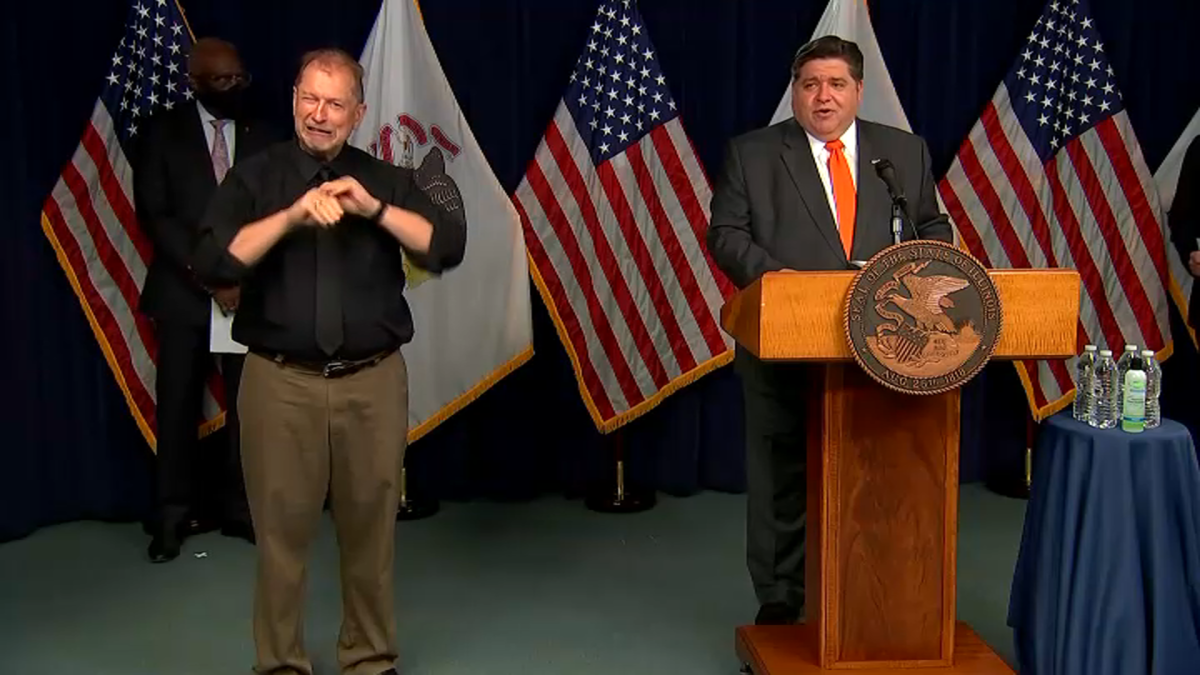
Illinois Gov. J.B. Pritzker delivers a coronavirus update from Chicago on Aug. 19.
What would it take for Illinois schools to be forced to close and return to all-remote learning as they were in the spring? According to Illinois Gov. J.B. Pritzker, there's no clear answer yet.
While several state districts have already announced plans to start the school year fully remote during the coronavirus pandemic, other districts have continued with plans to return to in-person learning while implementing masks and social distancing.
Still, with Illinois cases rising, some have questioned how long that may last.
Outside of K-12 schools, Notre Dame and Michigan State universities on Tuesday became the latest colleges to move classes online because of the coronavirus as colleges struggle to contain outbreaks.
But according to Pritzker, returning to fully remote statewide is "not currently the plan."
"Before most schools open, and we're very close to that now, we, you know, we're working very hard to at least flatten the numbers and then have them move in the right direction," Pritzker said during a coronavirus press briefing Wednesday. "And so we haven't set any parameters yet, for you know, what it would take to, for us to simply say, across the board, we're closing schools - that is not our aim. And we're hoping that schools have done a good job following our guidelines from the state board of education so that they'll open safely and in a way that's healthy for all the families, not to mention the teachers professionals and the students themselves."
Pritzker said that while new developments involving a saliva-based test from the University of Illinois could bring promising help for school districts, "it's not going to happen" before schools begin this new school year.
Local
According to Illinois Department of Public Health Director Dr. Ngozi Ezike and other health officials, the saliva-based tests are a major breakthrough in coronavirus testing for multiple reasons, including their cheaper costs, faster results and relative ease of accessing the materials needed to conduct and screen the tests.
Officials said students who take the test can have test results sent directly to their phones with their test results, which will likely be available within just 24 hours instead of the several days that nose swab tests take to process.
State officials are working to deploy the tests to more public universities across the state in coming weeks and months, and will work to make the testing available for students in K-12 schools and for residents of long-term care facilities as well.
"The University of Illinois from the beginning - and I've been in on these conversations for weeks - has been focused on how do we spread this across the state of Illinois?" Pritzker said. "That's what my goal is do it everywhere that... where there is a high need, trying to prioritize it as best we can. We have K-12 schools opening. We're not going to be able to get these tests in people's hands in districts before schools open in the next month."
At the same time, Pritzker acknowledged that the state's most recent plan aims to avoid making blanket restrictions for every region, instead opting to implement restrictions on a region-by-region basis.
"Getting our positivity rate as low as it can be is certainly a goal of mine," he said. "Getting a positivity rate of 1% would be phenomenal, would be among the best in the country... Everybody has their own view, about how comfortable they are. Remember, if you had cancer, and or you have some underlying condition, even if I told you that we had a 1% positivity rate you may choose on your own to stay home, that may be your choice. Yeah, I mean, that's what we're aiming at, right and we and we look, we read 2.6% I think statewide at one point... which is a very good number, right? And then we, as you know, we moved into phase four, things opened up more and guess what's happening? The numbers are going up. So now we're trying a more scalpel-like approach, right? To make sure that we're providing mitigations within regions."
Still, Pritzker said Wednesday that most of Illinois' 11 regions are seeing increases in positivity rates, with two in particular reporting "troubling trends" as the state continues to see a rise in coronavirus metrics.
Already, the state's Region 4, the Metro East region, is under stricter mitigation requirements implemented by the state after the area rose above an 8 percent positivity rate for three days in a row. As of Wednesday, the region had a positivity rate of 9.4 percent and Pritzker warned additional restrictions like the full closure of indoor dining and drinking could soon be put in place.
In addition to Region 4, Pritzker said Regions 2, 3, 4, 8, 9, 10 and 11 have also seen an increase in their seven-day rolling average positivity rate. Only three regions - Regions 1, 5 and 6 - have seen slight decreases.
"Across the state, our 11 Restore Illinois regions are trending in different directions, the majority of which are negative," Pritzker said.
Of those seeing increases in positivity rates, Pritzker said officials are "closely monitoring" what he called "troubling trends" in Region 7, which includes Kankakee and Will counties, as well as Region 5 in southern Illinois.
"I want to emphasize again that local elected officials and health officials should pay close attention to the data for their communities and, where necessary, step up and impose greater mitigations on a targeted basis to bring down the number of infections and the positivity rate," Pritzker said. "Otherwise, it may only be a matter of time before the state will be forced to step in on a regional basis in other areas and impose resurgence mitigations like closing bars, indoor dining, limiting all indoor gatherings to even smaller capacity and more to reduce the spread of the virus."